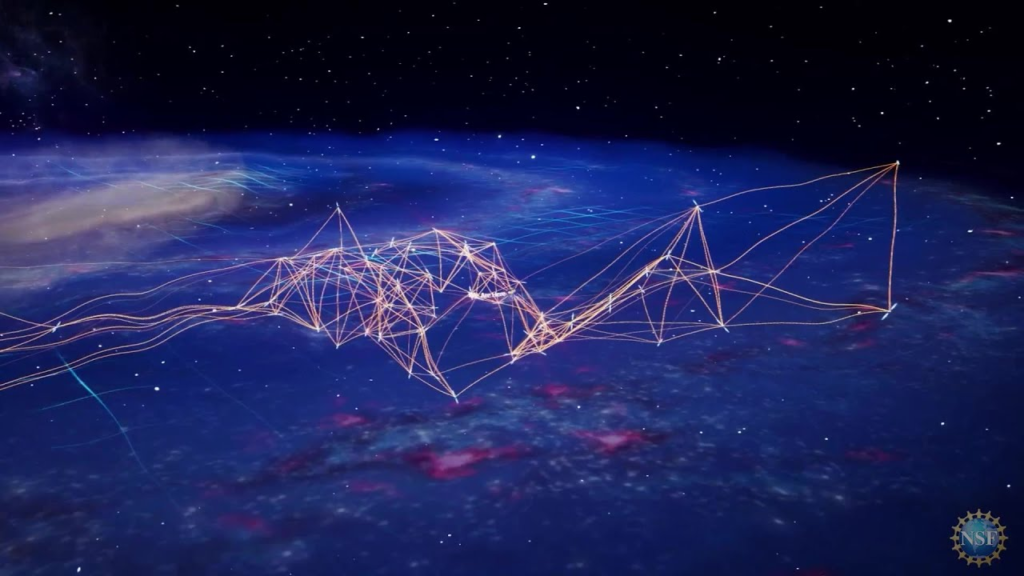UPSC Relevance
- Prelims Angle: Location of LIGO-India, role of SKA, concept of LISA, basics of gravitational waves.
● GS-3 (Science & Technology): Advances in physics, astronomy, and space-based observatories.
Why in News?
Scientists are planning to use the Moon as a new place to study gravitational waves (tiny ripples in space-time). A U.S. project called the Laser Interferometer Lunar Antenna (LILA) wants to build a detector in the Moon’s quiet polar regions, which are free from Earth’s noise and vibrations.

At the same time, India is building LIGO-India in Maharashtra, which will join the global network of gravitational-wave observatories by 2030. Together, these projects will help scientists detect new kinds of signals from the universe — like adding new “musical notes” to the cosmic symphony.
Background
Einstein’s General Theory of Relativity (1916) predicted gravitational waves — tiny ripples in the fabric of space and time.
These waves were first detected in 2015 by LIGO (U.S.), coming from the collision of two black holes 1.3 billion light-years away.
Today, several ground-based detectors exist:
- LIGO (U.S.)
- Virgo (Italy)
- KAGRA (Japan)
- GEO600 (Germany)
They can detect waves in the 100–1,000 Hz range, but much of the universe’s gravitational-wave signals — especially low-frequency ones — remain unexplored. This low-frequency “decihertz” range could reveal secrets about the early universe.
Global Efforts to Expand the Spectrum
1. Ground-Based Detectors:
- LIGO, Virgo, KAGRA detect high-frequency waves, but Earth’s vibrations limit their sensitivity.
2. Space-Based Missions:
- LISA (2030s): Three satellites in a triangle orbit behind Earth, detecting low-frequency waves (0.1 mHz–0.1 Hz).
- DECIGO (Japan) and TianGo (U.S.-led): Proposed missions to detect decihertz waves in space.
3. Radio Astronomy:
- Square Kilometre Array (SKA) in Australia & South Africa monitors pulsars to detect nanohertz waves.
4. Lunar-Based Detectors:
- LILA (U.S.) and LGWA (Europe) take advantage of the Moon’s quiet environment and low vibrations for sub-hertz gravitational-wave astronomy.
India’s Role: LIGO-India and Beyond
1. IndIGO (Indian Initiative in Gravitational-wave Observations):
- India’s plan to develop expertise and infrastructure in gravitational-wave astronomy.
2. LIGO-India (Hingoli, Maharashtra):
- Expected to be operational by 2030.
- Will join the global LIGO network, helping improve detection accuracy and sensitivity through triangulation.
3. Collaboration in Radio Astronomy:
- India also participates in the Square Kilometre Array (SKA) project.
- Using pulsar timing arrays, the Milky Way itself can act as a natural gravitational-wave detect
Significance of Gravitational-Wave Astronomy
1. New Frontier of Science:
- Lets scientists explore the “gravitational sky”, beyond what light and other electromagnetic waves can show.
2. Understanding Black Holes:
- Decihertz waves help study intermediate-mass black holes, the building blocks of supermassive black holes.
3. Probing the Early Universe:
- Gravitational waves travel unhindered across space, offering clues about the very early universe.
4. Global Collaboration:
- Projects like LIGO, LISA, SKA, and LILA foster science diplomacy and shared knowledge.
5. India’s Scientific Edge:
- LIGO-India positions India at the forefront of high-precision, cutting-edge physics research.
Challenges Ahead
1. Technological Gaps:
- Detecting decihertz waves is still very challenging; only the Moon currently offers a feasible environment.
2. High Costs:
- Space and lunar missions need billions of dollars and international collaboration.
3. Infrastructure & Talent:
- India needs stronger STEM education, more R&D funding, and global partnerships.
4. Sustainability of Big Science:
- Such projects require long-term political support and economic commitment.
Way Forward
- Accelerate LIGO-India: Ensure timely completion to integrate India into the global LIGO network.
- Lunar Collaborations: Explore synergy between Chandrayaan missions and future lunar observatories like LILA.
- Decihertz Research: Invest in India-led proposals for decihertz astronomy, bridging current spectrum gaps.
- Leverage Pulsar Timing Arrays: Use SKA participation to explore galaxy-wide gravitational-wave detection.
- Policy Push: Position India as a hub for space-science diplomacy in international collaborations.
Conclusion
Gravitational-wave astronomy is still in its infancy, but like a cosmic raag, it is slowly unfolding note by note. Earth-based detectors capture the high-pitched bursts, SKA listens to the deep bass tones, and future lunar missions promise to reveal the missing middle notes. Together, they will let humankind hear the full symphony of the universe — and perhaps even understand the story of its birth at the very edge of time and space.
Upsc prelims practice question-
Q. Which of the following projects is specifically designed to detect low-frequency gravitational waves in space?
A) LIGO
B) LISA
C) SKA
D) LIGO-India
Answer: B) LISA
Explanation: LISA (Laser Interferometer Space Antenna) is a space-based triangular satellite array designed to detect 0.1 mHz – 0.1 Hz gravitational waves.
Mains Question
Q: “Gravitational-wave astronomy is opening a new window to explore the universe beyond electromagnetic observations.” Discuss this statement with reference to India’s initiatives in gravitational-wave research and their significance for science and international collaboration. (150 words)
